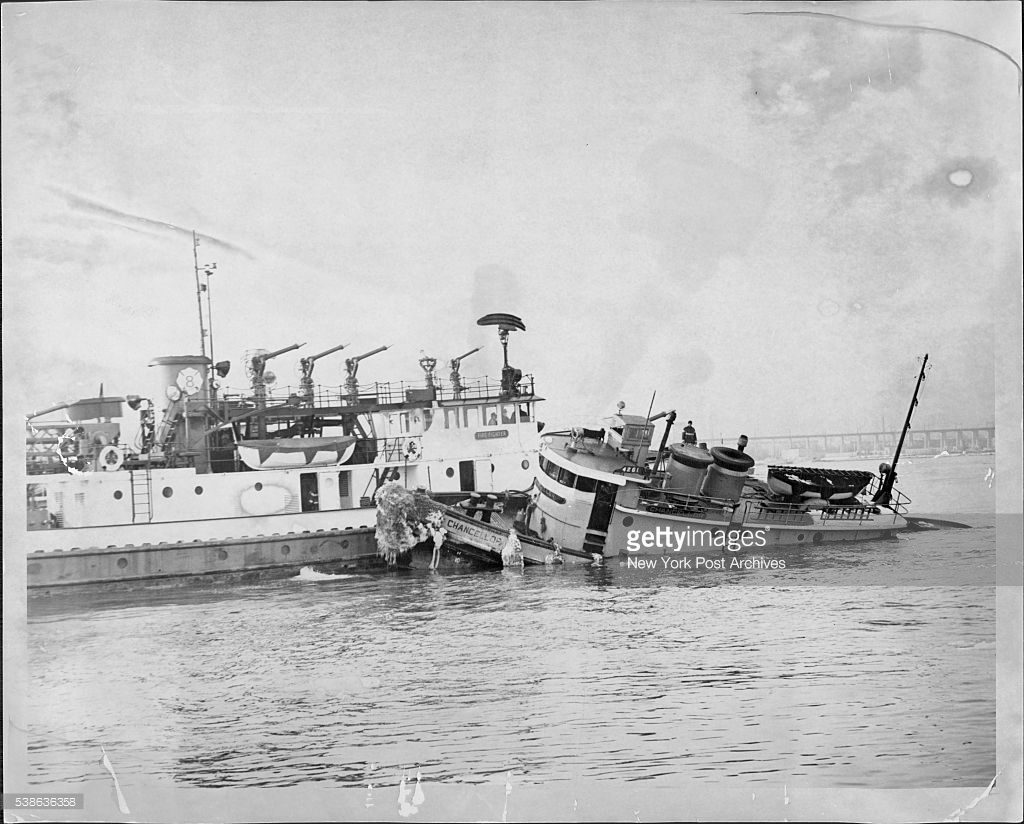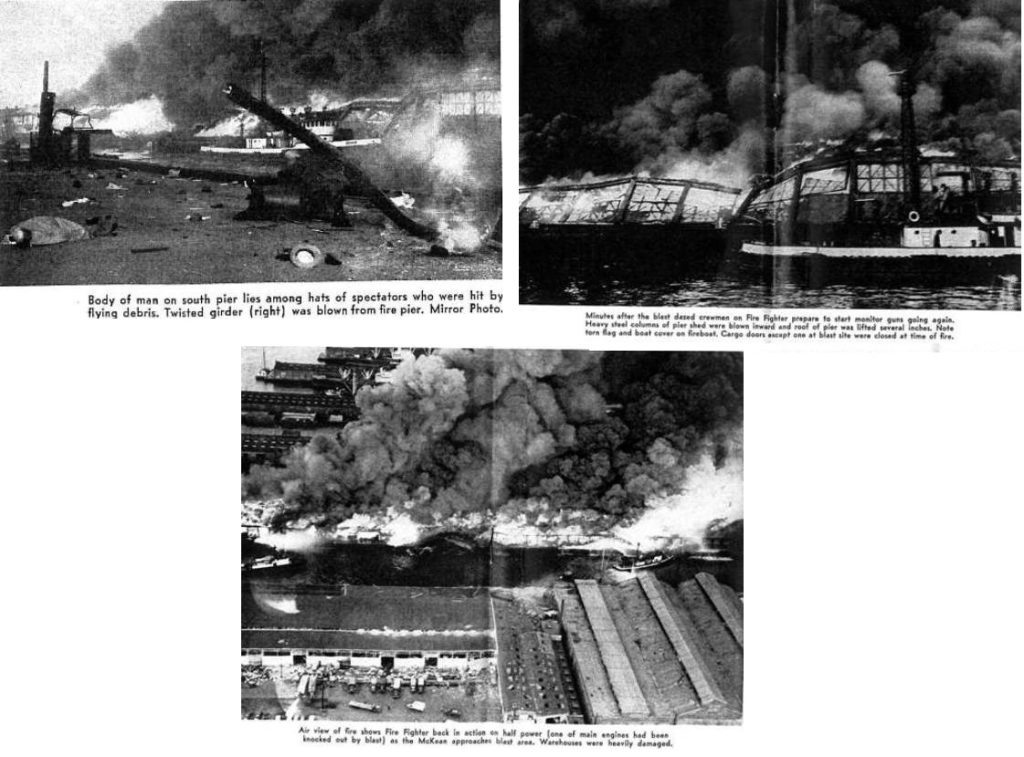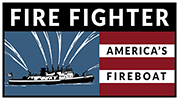
Fire Fighter, as Marine Unit 8/Engine 223 assists the commercial tug Chancellor in waters off present-day LaGuardia Airport after the tug was run down and holed by its tow. Pic from Getty Images
Situated at the Southern edge of the former US Navy South Brooklyn Fleet Supply Base, the quarters for Engine 223 were centrally located among the piers, railyards, terminals and shipyards of the Brooklyn waterfront, which at the time of Fire Fighter’s arrival in 1956 was seeing rapid growth and expansion as the majority of the large Steamship lines were relocating their freight operations out of their “up harbor” facilities. Once again assuming the role of first-due unit for the operational center of marine trade in New York Harbor, Fire Fighter and her crews at Engine 223 found themselves front and center for some of the most dynamic changes to the US merchant shipping fleet in American history as rapidly advancing technology, financial hardships and rollercoaster geopolitical relations all conspired to make her time at Marine 8 very interesting.
Already no stranger to the unique complexities of large pier fires in New York Harbor, Fire Fighter’s time at Marine 8 got off to a literal bang when she was dispatched to a Second Alarm for a fire burning on the nearby Lukenbach Steamship Co. 35th Street Pier on the 3rd of December 1956. Arriving onscene with some of the first land units and tying up alongside the heavily involved pier house, Fire Fighter’s monitors had just began sending water through one of the open freight doors when she was ordered to pull forward by 200ft by the 25th Battalion Chief so her monitors could be used to check the fires advance towards shore. As her bow line was made tight and her engineers were preparing to resume pumping water, a tremendous blast erupted from the pier house at the exact spot where Fighter had been previously berthed, flattening the crew on her deck, blowing out her pilothouse windows and knocking her Port engine out of action. A debris and shrapnel-filled blast wave tore through the surrounding area, killing 10 bystanders, injuring over 250 and blowing out every window in a three-block radius, in addition to showing the area in flaming debris that started dozens of new fires. Two Borough Calls were dispatched by the FDNY Brooklyn Central Office to deal with the resulting bedlam, and despite her damage Fire Fighter remained onscene and continued to work the fire with the rest of the FDNY Marine Fleet until the pier fires were under control. Limping away from what would go down in history as one of the worst and one of the last major pier fires in New York City history, Fire Fighter was sent to the shipyard for repairs which lasted through the first part of 1957.

A trio of newspaper photos of the Fire Fighter working the massive Pier 35 fire. Courtesy of http://marine1fdny.com
The high cost in life and property from the Lukenbach Steamship Pier fire led to intense scrutiny on the City of New York’s building inspectors and legislators, who began to crack down on steamship lines and pier operators to ensure proper fire prevention and suppression apparatus was in place in their facilities in New York Harbor. The associated costs that came with complying with these new regulations came at a dire time for most of the Steamship companies operating in New York Harbor, as by 1960 many were seeing their profits being severely undercut by foreign competition using cheaply-bought, worn-out 1940’s-era freighters and the maturation of loans many lines took out to rebuild their fleets with top-of-the line vessels. Things turned from bad to worse as containerization came into being, leaving American steamship lines with fleets of expensive, new and increasingly obsolete vessels which were being woefully outpaced by newbuild and converted ships carrying containers. A wave of bankruptcies and consolidations swept over New York Harbor’s steamship lines in the mid-1960’s, with many one-time competitors consolidating pier and terminal facilities while abandoning others alltogether. Still operating at razor-thin profit margins despite the reduced competition, many steamship lines chose to keep their investments in their relatively new vessels rather than their aging piers and terminals, and maintenance and upkeep for the majority of New York’s piers suffered heavily as a result.
Pier and terminal fires spiked around the harbor as a result of this grim new reality, as vandals, vagrants, arsonists and general decay led many of the old wooden piers to meet fiery ends. Like the rest of the FDNY Fleet, Fire Fighter and her crew became quite adept at the process of “deconstructing” fires on these facilities; whereupon confirmation that a structure was abandoned and clear of any persons her bow-mounted 5-inch monitor would be cranked up to maximum PSI and then used to physically batter down the structure into the harbor. Calls of this nature became so routine during the 1960’s that Fire Fighter earned her motto: “We don’t fight fires, We knock them down!”.
The 1960’s
Of course, it wasn’t all pier fires and demolition work for Fighter during her time at Marine 8. December of 1960 brought a call for her to join the entire FDNY Fleet at the Brooklyn Navy Yard where a fire had broken out aboard the Aircraft Carrier USS Constellation (CV-64), then in the final stages of a three-year construction period. Caused by an accidental impact of a metal plate with the spigot of a 500-gallon diesel fuel tank, the resulting fire burned for over 17 hours and claimed the lives of 50 shipyard workers before being brought under control by the combined efforts of hundreds of FDNY firefighters, many of whom had come straight from marathon duties at the site of the Park Slope Air Disaster.
By the latter half of the 1960’s the environment around Fire Fighter’s quarters at Engine 223 couldn’t have been any more different than when she first arrived in 1956. Gone were the majority of smaller steamship lines, and many of the once-bustling piers, terminals and quays were now lying silent after being idled or abandoned. Things were very different across the harbor however, as the newly-opened Port Elizabeth Marine Terminal in Elizabeth, NJ was experiencing a period of steady growth in the number of container ships, bulk freighters and tankers calling its piers. Though the breakbulk shipping market appeared to be stabilizing by 1965, it was clear that the harbor was undergoing another fundamental shift in its marine trade lanes away from Brooklyn, and indeed most of New York Harbor and towards New Jersey and Staten Island.
With Fire Fighter once again being steadily left behind by the changing trade patterns, the FDNY, which was already feeling the sting of tighter budgets and eyeing the expansive Marine Unit as ripe for budget cuts, briefly considered retiring the Fighter in favor of newer, less powerful but cheaper fireboats which were beginning to replace some of the oldest members of the fleet which had been built around the turn of the century. Making it past the 1965-66 budget axe but very much in the crosshairs, Fighter reported to Caddell’s shipyard on Staten Island in June of 1966 for repainting and upkeep, and was pierside and covered in scaffolding when the tanker Alva Cape steamed by on the morning of June 16th, 1966, riding the tide towards Bayway Oil Refinery.
T-boned moments later by the tanker Texaco Massachusetts while passing Bergen Point, the naptha-laden Alva Cape exploded into a firestorm which consumed the ship, two assisting tugboats and badly damaged the Texaco Massachusetts, while claiming the lives of 32 mariners and injuring a further 13. The disaster warranted a full unit response from the FDNY fireboat fleet, including the Fighter, who were able to contain and eventually snuff the flames in slightly over two hours despite the extremely challenging nature of the fire. Fire Fighter proved her mettle once again as a indispensable firefighting asset when she was able to use her topside monitors to completely shield the fireboat Alfred E. Smith from both heat and flame as she moved between the burning tankers to rescue trapped crewmen.

Fire Fighter is visible beneath the Bayonne Bridge as she responds to the scene. Original pic is courtesy of the NY Daily News
The subsequent public and commercial concerns about the safety of life and property in the Arthur Kill, Kill Van Kull and Elizabeth Bay in the aftermath of the Texaco Massachusetts/Alva Cape collision, along with the lengthy response time for the FDNY Marine Fleet to the scene gave the FDNY all the impetus needed to proceed with the relocation of their still most-potent asset, Fire Fighter, to a location where she could once again be the first-due unit to the center of trade in the harbor. Fire Fighter subsequently spent the balance of 1966 on duty with Engine 223 and Marine 8 before reporting to the quarters of Engine 51, Marine Unit 9 at Pier 6 at the foot of Hannah Street on Staten Island in the beginning of 1967, swapping places with the 1958-built H. Sylvia A. H. G. Wilks.


